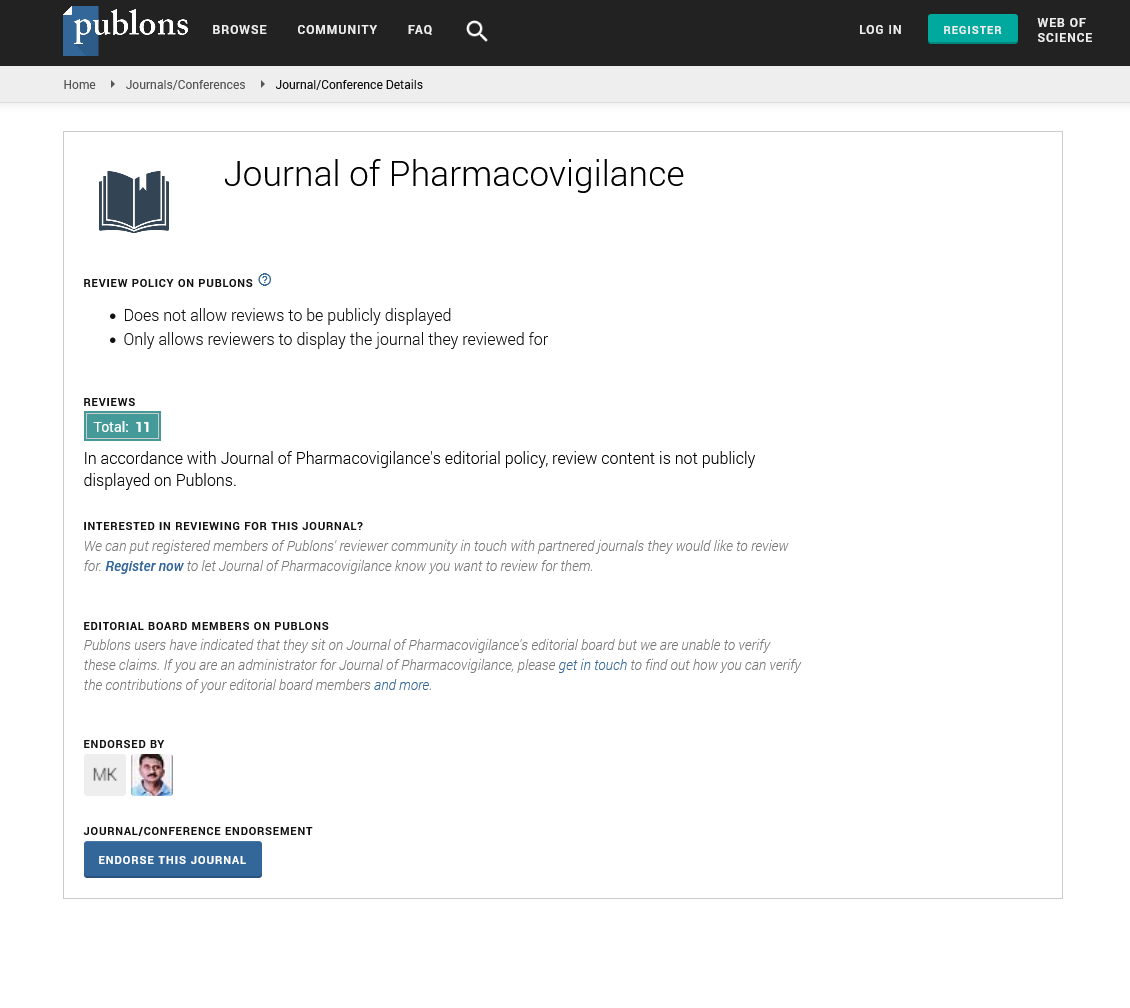Indexed In
- Open J Gate
- JournalTOCs
- The Global Impact Factor (GIF)
- RefSeek
- Hamdard University
- EBSCO A-Z
- OCLC- WorldCat
- Publons
- Euro Pub
- Google Scholar
Useful Links
Share This Page
Journal Flyer

Open Access Journals
- Agri and Aquaculture
- Biochemistry
- Bioinformatics & Systems Biology
- Business & Management
- Chemistry
- Clinical Sciences
- Engineering
- Food & Nutrition
- General Science
- Genetics & Molecular Biology
- Immunology & Microbiology
- Medical Sciences
- Neuroscience & Psychology
- Nursing & Health Care
- Pharmaceutical Sciences
Perspective - (2024) Volume 12, Issue 3
Geriatric Pharmacovigilance: Addressing the Unique Needs of Older Adults
Cormac Malley*Received: 28-Aug-2024, Manuscript No. JP-24-27169; Editor assigned: 30-Aug-2024, Pre QC No. JP-24-27169(PQ); Reviewed: 13-Sep-2024, QC No. JP-24-27169; Revised: 20-Sep-2024, Manuscript No. JP-24-27169(R); Published: 27-Sep-2024, DOI: 10.35248/2329-6887.24.12.486
Description
The aging population is growing rapidly across the globe, leading to an increased focus on healthcare for older adults. Geriatric pharmacovigilance, the science of monitoring and assessing the safety of medications in older adults, is becoming increasingly important. Older adults often have unique healthcare needs due to the presence of multiple chronic conditions, age-related physiological changes and the use of multiple medications, known as polypharmacy. Ensuring the safe and effective use of medications in this population requires specialized pharmacovigilance strategies that address their unique challenges. Older adults are more likely to be prescribed multiple medications, increasing the risk of drug-drug interactions and Adverse Drug Reactions (ADRs). Effective pharmacovigilance helps identify potential interactions and manage polypharmacy safely. Age-related changes in pharmacokinetics (how the body absorbs, distributes, metabolizes and excretes drugs) and pharmacodynamics (how drugs affect the body) can alter the safety and efficacy of medications. Geriatric pharmacovigilance takes these changes into account to ensure appropriate dosing and monitoring. Many older adults have multiple chronic conditions, requiring ongoing medication management. Monitoring the safety of long-term drug use in this population is potential for preventing adverse outcomes. Older adults may be more vulnerable to the side effects of medications due to frailty, cognitive impairment and other age-related factors. Tailored pharmacovigilance strategies help protect this vulnerable population. ADRs are often underreported in older adults, either because symptoms are mistaken for normal aging or because healthcare providers are not aware of reporting mechanisms. Improving ADR reporting is essential for identifying safety issues. The complexity of medication regimens in older adults, including the use of prescription drugs, over-the-counter medications and dietary supplements, can make it difficult to identify the cause of ADRs.
Older adults are often underrepresented in clinical trials, leading to limited data on the safety and efficacy of medications in this population. More inclusive research is needed to inform pharmacovigilance practices. Cognitive impairment, hearing loss and other age-related conditions can make it challenging for older adults to communicate their symptoms and concerns. Healthcare providers need effective communication strategies to ensure accurate reporting of ADRs. Encouraging healthcare providers and patients to report ADRs is potential. Simplified reporting systems, including online portals and mobile apps, can make it easier to report and track ADRs. Education and training programs for healthcare providers can also raise awareness about the importance of ADR reporting. Regular medication reviews by healthcare professionals can help identify potential drug interactions, inappropriate medications and other safety concerns. These reviews should involve a thorough assessment of all medications, including over-the-counter drugs and supplements. Integrating Electronic Health Record (EHR) with pharmacovigilance systems can improve the tracking and analysis of medication use and ADRs in older adults. EHRs can provide real-time data on patients' medication histories, helping healthcare providers make informed decisions and identify potential safety issues. Customized medication regimens based on individual characteristics, such as genetic factors, comorbidities and lifestyle, can enhance the safety and efficacy of treatments in older adults. Pharmacogenomics, the study of how genes affect drug responses, is a promising field for personalized medicine. Providing healthcare providers with specialized training in geriatric pharmacovigilance can improve their ability to identify and manage ADRs in older adults. Training programs should cover the unique physiological changes, common drug interactions and appropriate dosing strategies for this population.
Conclusion
Effective communication between healthcare providers, patients and caregivers is essential for ensuring the safe use of medications. Collaborative care models, such as multidisciplinary teams, can enhance communication and coordination of care. A notable example of efforts to enhance geriatric pharmacovigilance is the U.S. Medicare Part D program, which provides prescription drug coverage for older adults. Medicare Part D offers MTM services for eligible beneficiaries, providing comprehensive medication reviews, education, and counseling. These services help identify and resolve medication-related issues, improving safety and adherence. Medicare Part D uses data analysis and surveillance to monitor medication use and identify safety concerns. This proactive approach helps detect potential issues early and implement targeted interventions.
Citation: Malley C (2024). Geriatric Pharmacovigilance: Addressing the Unique Needs of Older Adults. J Pharmacovigil. 12:486.
Copyright: © 2024 Malley C. This is an open-access article distributed under the terms of the Creative Commons Attribution License, which permits unrestricted use, distribution, and reproduction in any medium, provided the original author and source are credited.

